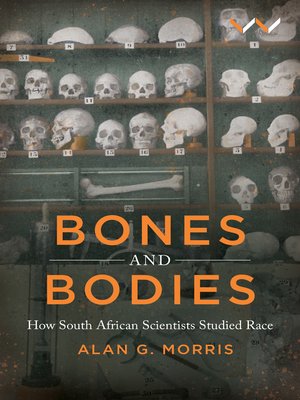
Sign up to save your library
With an OverDrive account, you can save your favorite libraries for at-a-glance information about availability. Find out more about OverDrive accounts.
Find this title in Libby, the library reading app by OverDrive.



Search for a digital library with this title
Title found at these libraries:
| Library Name | Distance |
|---|---|
| Loading... |
Bones and Bodies is a highly accessible account of the establishment of the scientific discipline of biological anthropology. Alan G Morris takes us back over the past century of anthropological discovery in South Africa and uncovers the stories of individual scientists and researchers who played a significant role in shaping perceptions of how peoples of southern Africa, both ancient and modern, came to be viewed and categorised both in the public imagination and the scientific literature. Morris reveals how much of the earlier anthropological studies were tainted with the tarred brush of race science. He evaluates the works of famous anthropologists and archaeologists such as Raymond Dart, Thomas Dreyer, Matthew Drennan and Robert Broom, and demonstrates through a wide array of sources how they described their fossil discoveries through the prism of racist interpretation. Morris also shows how modern anthropology tried to rid itself of the stigma of these early racist accounts. In the 1960s and 1970s, Ronald Singer and Phillip Tobias introduced modern methods into the discipline that disputed much of what the public believed about race and human evolution. In an age in which the authority of experts and empirical science is increasingly being questioned, this book shows the battle facing modern anthropology to acknowledge its racial past but also how its study of human variation remains an important field of enquiry at institutions of higher learning.|Bones and Bodies is a highly accessible account of the establishment of the scientific discipline of biological anthropology. Alan G Morris takes us back over the past century of anthropological discovery in South Africa and uncovers the stories of individual scientists and researchers who played a significant role in shaping perceptions of how peoples of southern Africa, both ancient and modern, came to be viewed and categorised both in the public imagination and the scientific literature. Morris reveals how much of the earlier anthropological studies were tainted with the tarred brush of race science, evaluating the works of famous anthropologists and archaeologists such as Raymond Dart, Thomas Dreyer, Matthew Drennan and Robert Broom. Morris also considers how modern anthropology tried to rid itself of the stigma of these early racist accounts. In the 1960s and 1970s, Ronald Singer and Phillip Tobias introduced modern methods into the discipline that disputed much of what the public wished to believe about race and human evolution. Bones and Bodies shows the battle facing modern anthropology to acknowledge its racial past but also how its study of human variation remains an important field of enquiry at institutions of higher learning.







